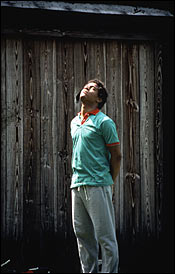
Jean-Michel Basquiat is one of art’s shooting stars, a painter who developed a flashy early style and then flamed out, dying in 1988 of a drug overdose at the age of 27. That alone makes him irresistible to many: The story of the doomed artist who dies young is one of the great weepies of Western culture. (It doesn’t hurt that Basquiat was handsome, with a beautiful lost-child look.) But Basquiat also did something more interesting than play this romantic part. He captured the downtown pulse of his time, for good and ill, and defined some key cultural crossovers. The son of Haitian and Puerto Rican parents, he embodied the emerging doctrine of multiculturalism and jumbled up various traditions with devil-may-care energy. If he relished the mean streets and painted raw-looking images, he also came from a middle-class family and cultivated fame, charming Andy Warhol and his glitzy circle. He was at once self-taught and sophisticated, glamorous and ghetto-rough, the outlaw who’s the toast of society. So many people today want to play that gig.
Like most retrospectives, “Basquiat,” which opened last week at the Brooklyn Museum of Art, is large, conscientious, and celebratory. It was put together by four curators—Marc Mayer, Fred Hoffman, Kellie Jones, and Franklin Sirmans—and includes more than 70 paintings and twenty works on paper spread over two floors. Much of the information presented is interesting, particularly the analysis of Basquiat’s rich stew of iconographic sources. But there’s also something overearnest, even holy about “Basquiat.” Whatever his charm, this emblematic painter of the eighties deserves a more shadowed presentation. The art world then was feverish. The drug use, greed, social lust, and juiced-up sense of showbiz created a Dionysian hothouse. (Enough money went up art’s nose to feed the Third World for a year.) Everyone seemed to be onstage. The best-known photo of Basquiat, which shows him sitting barefoot in an elegant suit in front of a savage-looking painting, perfectly captures the stylish narcissism and crossover aesthetics of the time.
Before settling down as a painter, Basquiat, who always wanted to be a star, dabbled in music and graffiti, spray-painting cryptic messages on Soho walls. He looked hard at modern art and obviously found inspiration in the modernist role of the rebel. He did not have much formal training as a painter and did not pretend otherwise, perhaps sensing that without a long apprenticeship, pretenders to the high tradition become derivative artists. Instead, he developed a distinctive, rough style that has the aura of a self-taught, sui generis outsider who lives in the middle of nowhere. Except, of course, that this smart naïf lived in the heart of the New York art world. In Basquiat’s best pictures, the skeletal, puppetlike figures have an eruptive electric intensity, like those cartoon characters that get plugged into a light socket or those African or Caribbean figures who vibrate with such spiritual intensity, they’re shaken free of the ordinary.
Basquiat would often scrawl words across a picture and make rough marks that look like half-formed letters. Many images resemble doodles more than they do graffiti and have an air of hieroglyphic reverie as well as an electric pop. It’s impossible to locate their precise meaning, and if the larger composition is slack or slapdash, the mind’s eye quickly grows impatient, for Basquiat is an extremely uneven artist who released too much from his studio. But the refusal to be precise can also open the way, at best, to a glimpsing sort of poetry. It can convey desperation, too—an obsessive scribbling around for something that cannot be found. Among the many heroes in Basquiat’s work is the jazz saxophonist Charlie Parker, who also died young. Although Basquiat is often compared to today’s hip-hop artists, he’s more like Bird, the champion of improvisation, an artist smooth and unpretty who gathered bits of melody from every direction and gave them an eccentric stitch.
Basquiat
Brooklyn Museum. Through June 5.